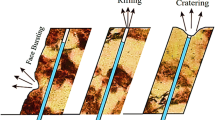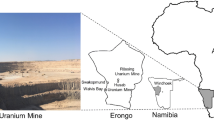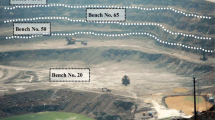Abstract
In the process of open-pit bench blasting for many mines, rock fragments move in the direction of loose space after fragmentation under explosive energy, leading to ore distribution differences before and after blasting. Considering that there is no simple and inexpensive method for post-blast ore boundary determination, a machine-learning-aided determination method and a corresponding evaluation system are proposed. In this regard, 95 datasets with nine variables were investigated using different kinds of predictive models: support vector regression, the Gaussian process (GP), extreme learning machine, and two metaheuristic algorithms. By evaluating the predictive performance using three performance metrics, absolute error comparison, and Taylor diagram, a hybrid model composed of whale optimization algorithm (WOA) and GP, namely WOA–GP, was found to be the best precision model. Then, a blast block with 55 blast holes was assumed and was analyzed using the WOA–GP model and the established evaluation system. It was found that using the post-blast ore boundary to guide the shovel can decrease the ore loss rate by 33.1% and the ore dilution rate by 57.9%, meaning that the methodology has great significance for improving resource recovery and increasing economic benefits. In addition, the mixing of high-grade and low-grade rock fragments during the geological modeling process may also cause ore loss and dilution. This article provides a new methodology for post-blast ore boundary determination, which can inspire development of other ore loss and dilution management techniques.













Similar content being viewed by others
Notes
1 mile = 1.60934 km.
1 lb = 0.453592 kg.
References
Armaghani, D. J., Hasanipanah, M., Amnieh, H. B., & Mohamad, E. T. (2018). Feasibility of ICA in approximating ground vibration resulting from mine blasting. Neural Computing and Applications, 29(9), 457–465.
Asteris, P. G., & Nikoo, M. (2019). Artificial bee colony-based neural network for the prediction of the fundamental period of infilled frame structures. Neural Computing and Applications, 31(9), 4837–4847.
Bui, X.-N., Nguyen, H., Le, H.-A., Bui, H.-B., & Do, N.-H. (2020). Prediction of blast-induced air over-pressure in open-pit mine: Assessment of different artificial intelligence techniques. Natural Resources Research, 29(2), 571–591.
Chang, C. C, & Lin, C. J. (2011). LIBSVM: A library for support vector machines. ACM Transactions on Intelligent Systems and Technology, 2(3), 1–27. https://doi.org/10.1145/1961189.1961199
Engmann, E., Ako, S., Bisiaux, B., Rogers, W., & Kanchibotla, S. (2013). Measurement and modelling of blast movement to reduce ore losses and dilution at Ahafo Gold Mine in Ghana. Ghana Mining Journal, 14, 27–36.
Eshun, P. A., & Dzigbordi, K. A. (2016). Control of ore loss and dilution at anglogold ashanti, iduapriem mine using blast movement monitoring system. Ghana Mining Journal, 16(1), 49–59.
Faramarzi, A., Heidarinejad, M., Stephens, B., & Mirjalili, S. (2020). Equilibrium optimizer: A novel optimization algorithm. Knowledge-Based Systems, 191, 105190.
Gilbride, L. (1995). Blast-induced rock movement modelling for Nevada gold mines. University of Nevada, Reno.
Guo, H., Zhou, J., Koopialipoor, M., Jahed Armaghani, D., & Tahir, M. M. (2021). Deep neural network and whale optimization algorithm to assess flyrock induced by blasting. Engineering with Computers, 37, 173–186. https://doi.org/10.1007/s00366-019-00816-y
Harris, G. W., Mousset-Jones, P., & Daemen, J. (2001). Blast movement measurement to control dilution in surface mines. CIM Bulletin, 94(1047), 52–55.
Hasanipanah, M., Naderi, R., Kashir, J., Noorani, S. A., & Qaleh, A. Z. A. (2017). Prediction of blast-produced ground vibration using particle swarm optimization. Engineering with Computers, 33(2), 173–179.
Holland, J. H. (1975). Adaptation in natural and artificial systems: An introductory analysis with applications to biology, control, and artificial intelligence. University of Michigan Press.
Huang, G. B., Zhu, Q. Y., & Siew, C. K. (2006). Extreme learning machine: Theory and applications. Neurocomputing, 70(1–3), 489–501.
Huo, X., Shi, X., Qiu, X., Zhou, J., Gou, Y., Yu, Z., & Ke, W. (2020). Rock damage control for large-diameter-hole lateral blasting excavation based on charge structure optimization. Tunnelling and Underground Space Technology, 106, 103569. https://doi.org/10.1016/j.tust.2020.103569.
Imani, M., Kao, H. C., Lan, W. H., & Kuo, C. Y. (2018). Daily sea level prediction at Chiayi coast, Taiwan using extreme learning machine and relevance vector machine. Global and Planetary Change, 161(July 2017), 211–221.
Isaaks, E., Barr, R., & Handayani, O. (2014). Modelling blast movement for grade control. In: proceedings ninth international mining geology conference (pp. 433–440). https://www.ausimm.com.au/publications/epublication.aspx?ID=16027
Kaloop, M. R., Kumar, D., Samui, P., Gabr, A. R., Hu, J. W., Jin, X., & Roy, B. (2019). Particle Swarm Optimization algorithm-Extreme Learning Machine (PSO-ELM) model for predicting resilient modulus of stabilized aggregate bases. Applied Sciences (switzerland), 9(16), 3221. https://doi.org/10.3390/app9163221
Khandelwal, M., & Armaghani, D. J. (2016). Prediction of drillability of rocks with strength properties using a hybrid GA-ANN technique. Geotechnical and Geological Engineering, 34(2), 605–620.
Koopialipoor, M., Murlidhar, B. R., Hedayat, A., Armaghani, D. J., Gordan, B., & Mohamad, E. T. (2019). The use of new intelligent techniques in designing retaining walls. Engineering with Computers, 36, 283–294. https://doi.org/10.1007/s00366-018-00700-1
Le, L. T., Nguyen, H., Zhou, J., Dou, J., & Moayedi, H. (2019). Estimating the heating load of buildings for smart city planning using a novel artificial intelligence technique PSO-XGBoost. Applied Sciences (switzerland), 9(13), 2714. https://doi.org/10.3390/APP9132714
Li, S., Chen, H., Wang, M., Heidari, A. A., & Mirjalili, S. (2020). Slime mould algorithm: A new method for stochastic optimization. Future Generation Computer Systems, 111(April), 300–323.
Lin, Y., Zhou, K., & Li, J. (2018). Prediction of slope stability using four supervised learning methods. IEEE Access, 6, 31169–31179.
Lucas, R., & Nies, D. (1990). Improving Fragmentation and Ore Displacement Control. In Proceedings of the Sixteenth Conference on Explosives and Blasting Technique (pp. 409–422).
Mirjalili, S., & Lewis, A. (2016). The Whale Optimization Algorithm. Advances in Engineering Software, 95, 51–67.
Nguyen, H., Bui, X. N., Bui, H. B., & Cuong, D. T. (2019). Developing an XGBoost model to predict blast-induced peak particle velocity in an open-pit mine: A case study. Acta Geophysica, 67(2), 477–490.
Nguyen, H., Bui, X. N., Choi, Y., Lee, C. W., & Armaghani, D. J. (2021). A novel combination of whale optimization algorithm and support vector machine with different kernel functions for prediction of blasting-induced fly-rock in quarry mines. Natural Resources Research, 30(1), 191–207.
Preece, D. S., Silling, S. A. (2016). Ore loss and dilution studies of surface mineral blasting with 3D distinct element heave models. In 42nd Annual Conference on Explosive and Blasting Technique, International Society of Explosives Engineers (ISEE). Sandia National Lab. (SNL-NM), Albuquerque, NM (United States).
Preece, D. S., & Taylor, L. M. (1989). Complete computer simulation of crater blasting including fragmentation and rock motion. Sandia National Labs., Albuquerque, NM (USA).
Qi, C., Zhou, W., Lu, X., Luo, H., Pham, B. T., & Yaseen, Z. M. (2020). Particulate matter concentration from open-cut coal mines: A hybrid machine learning estimation. Environmental Pollution, 263, 114517.
Qiu, J., Guo, Z., Li, L., Zhang, S., Zhao, Y., & Ma, Z. (2020). A hybrid artificial intelligence model for predicting the strength of foam-cemented paste backfill. IEEE Access, 8, 84569–84583.
Rasmussen, C. E. (2004). Gaussian processes in machine learning. In: Bousquet O., von Luxburg U., Rätsch G. (eds) Advanced Lectures on Machine Learning. ML 2003. Lecture Notes in Computer Science, vol. 3176. Springer, Berlin, Heidelberg. https://doi.org/10.1007/978-3-540-28650-9_4
Rovini, E., Maremmani, C., Moschetti, A., Esposito, D., & Cavallo, F. (2018). Comparative motor pre-clinical assessment in Parkinson’s disease using supervised machine learning approaches. Annals of Biomedical Engineering, 46(12), 2057–2068.
Ruiseco, J. R., & Kumral, M. (2017). A practical approach to mine equipment sizing in relation to dig-limit optimization in complex orebodies: multi-rock type, multi-process, and multi-metal case. Natural Resources Research, 26(1), 23–35.
Ruiseco, J. R., Williams, J., & Kumral, M. (2016). Optimizing ore-waste dig-limits as part of operational mine planning through genetic algorithms. Natural Resources Research, 25(4), 473–485.
Sain, S. R., & Vapnik, V. N. (1995). The nature of statistical learning theory. Technometrics (Vol. 38). Springer. https://doi.org/10.2307/1271324
Sari, Y. A., & Kumral, M. (2018). Dig-limits optimization through mixed-integer linear programming in open-pit mines. Journal of the Operational Research Society, 69(2), 171–182.
Sarkka, S., Alvarez, M. A., & Lawrence, N. D. (2019). Gaussian process latent force models for learning and stochastic control of physical systems. IEEE Transactions on Automatic Control, 64(7), 2953–2960.
Taylor, S. L. (1995). Blast induced movement and its effect on grade dilution at the Coeur Rochester Mine. University of Nevada, Reno.
Thornton, D. (2009). The Implications of Blast-Induced Movement to Grade Control. In Seventh international mining geology conference (pp. 17–19).
Vasylchuk, Y. V., & Deutsch, C. V. (2018). Improved grade control in open pit mines. Mining Technology: Transactions of the Institute of Mining and Metallurgy, 127(2), 84–91.
Wang, M., Shi, X., & Zhou, J. (2018). Charge design scheme optimization for ring blasting based on the developed Scaled Heelan model. International Journal of Rock Mechanics and Mining Sciences, 110(February), 199–209.
Wang, S., Li, L., Cheng, S., Yang, J., Jin, H., Gao, S., & Wen, T. (2021). Study on an improved real-time monitoring and fusion prewarning method of water inrush in tunnels. Tunnelling and Underground Space Technology, 112, 103884.
Whitley, D. (1994). A genetic algorithm tutorial. Statistics and Computing, 4(2), 65–85.
Williams, J., Singh, J., Kurmal, M., & Ruiseco, J. R. (2021). Exploring deep learning for dig-limit optimization in open-pit mines. Natural Resources Research, 30(3), 2085–2101.
Yang, R. L., & Kavetsky, A. (1990). A three dimensional model of muckpile formation and grade boundary movement in open pit blasting. International Journal of Mining and Geological Engineering, 8(1), 13–34.
Yang, R. L., Kavetsky, A., & McKenzie, C. K. (1989). A two-dimensional kinematic model for predicting muckpile shape in bench blasting. International Journal of Mining and Geological Engineering, 7(3), 209–226.
Yaseen, Z. M., Faris, H., & Al-Ansari, N. (2020). Hybridized extreme learning machine model with Salp swarm algorithm: a novel predictive model for hydrological application. Complexity. https://doi.org/10.1155/2020/8206245
Yennamani, A. L. (2010). Blast induced Rock Movement Measurement for grade control at the Phoenix mine. University of Nevada, Reno.
Yennamanl, A. L., Aquirre, S., & Mousset-Jones, P. (2011). Blast-induced rock movement measurement for grade control. Mining Engineering, 63(2), 34–39.
Yu, Z., Shi, X., Qiu, X., Zhou, J., Chen, X., & Gou, Y. (2020a). Optimization of post-blast ore boundary determination using a novel sine cosine algorithm-based random forest technique and Monte Carlo simulation. Engineering Optimization. https://doi.org/10.1080/0305215X.2020.1801668
Yu, Z., Shi, X., Zhou, J., Chen, X., Miao, X., Teng, B., & Ipangelwa, T. (2020b). Prediction of blast-induced rock movement during bench blasting: Use of Gray Wolf optimizer and support vector regression. Natural Resources Research, 29(2), 843–865.
Yu, Z., Shi, X., Zhou, J., Rao, D., Chen, X., Dong, W., et al. (2021). Feasibility of the indirect determination of blast-induced rock movement based on three new hybrid intelligent models. Engineering with Computers, 37(2), 991–1006.
Zareifard, M. R. (2020). A new semi-numerical method for elastoplastic analysis of a circular tunnel excavated in a Hoek-Brown strain-softening rock mass considering the blast-induced damaged zone. Computers and Geotechnics, 122(August 2019), 103476.
Zhang, H., Zhou, J., Jahed Armaghani, D., Tahir, M. M., Pham, B. T., & Van Huynh, V. (2020a). A combination of feature selection and random forest techniques to solve a problem related to blast-induced ground vibration. Applied Sciences, 10(3), 869.
Zhang, P., Wu, H. N., Chen, R. P., & Chan, T. H. T. (2020b). Hybrid meta-heuristic and machine learning algorithms for tunneling-induced settlement prediction: A comparative study. Tunnelling and Underground Space Technology, 99(May 2019), 103383.
Zhang, S. L. (1994). Rock movement due to blasting and its impact on ore grade control in Nevada open pit gold mines. University of Nevada, Reno.
Zhao, Z., & Hu, M. (2014). Multi-level forecasting model of coal mine water inrush based on self-adaptive evolutionary extreme learning machine. Applied Mathematics & Information Sciences Letters, 2(3), 103–110.
Zhou, J., Chen, C., Wang, M., Khandelwal, M. (2021b). Proposing a novel comprehensive evaluation model for the coal burst liability in underground coal mines considering uncertainty factors. International Journal of Mining Science and Technology (In Press).
Zhou, J., Li, C., Arslan, C. A., Hasanipanah, M., & Bakhshandeh Amnieh, H. (2021a). Performance evaluation of hybrid FFA-ANFIS and GA-ANFIS models to predict particle size distribution of a muck-pile after blasting. Engineering with Computers, 37, 265–274. https://doi.org/10.1007/s00366-019-00822-0
Zhou, J., Li, X., & Mitri, H. S. (2018). Evaluation method of rockburst: State-of-the-art literature review. Tunnelling and Underground Space Technology, 81, 632–659.
Zhou, J., Nekouie, A., Arslan, C. A., Pham, B. T., & Hasanipanah, M. (2020). Novel approach for forecasting the blast-induced AOp using a hybrid fuzzy system and firefly algorithm. Engineering with Computers, 36, 703–712. https://doi.org/10.1007/s00366-019-00725-0
Zorlu, K., Gokceoglu, C., Ocakoglu, F., Nefeslioglu, H. A., & Acikalin, S. (2008). Prediction of uniaxial compressive strength of sandstones using petrography-based models. Engineering Geology, 96(3–4), 141–158.
Acknowledgments
This study is supported by the National Natural Science Foundation Project of China (Grant Nos. 51874350 and 41807259), the National Key R&D Program of China (2017YFC0602902), the Fundamental Research Funds for the Central Universities of Central South University (2018zzts217), and the Innovation-Driven Project of Central South University (2020CX040).
Author information
Authors and Affiliations
Corresponding author
Rights and permissions
About this article
Cite this article
Yu, Z., Shi, X., Zhou, J. et al. Machine-Learning-Aided Determination of Post-blast Ore Boundary for Controlling Ore Loss and Dilution. Nat Resour Res 30, 4063–4078 (2021). https://doi.org/10.1007/s11053-021-09914-5
Received:
Accepted:
Published:
Issue Date:
DOI: https://doi.org/10.1007/s11053-021-09914-5




